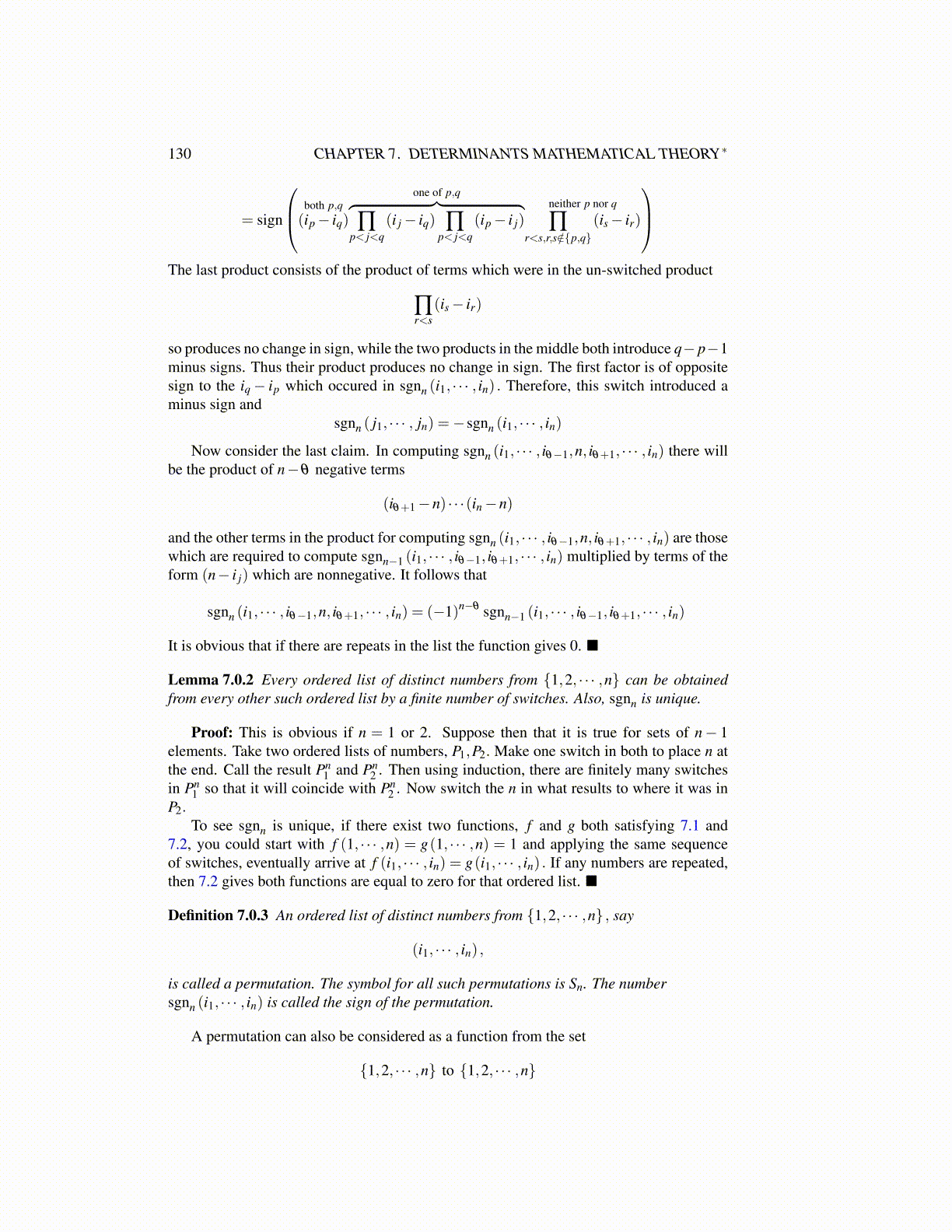
130 CHAPTER 7. DETERMINANTS MATHEMATICAL THEORY∗
= sign
both p,q(ip− iq)
one of p,q︷ ︸︸ ︷∏
p< j<q(i j− iq) ∏
p< j<q(ip− i j)
neither p nor q
∏r<s,r,s/∈{p,q}
(is− ir)
The last product consists of the product of terms which were in the un-switched product
∏r<s
(is− ir)
so produces no change in sign, while the two products in the middle both introduce q− p−1minus signs. Thus their product produces no change in sign. The first factor is of oppositesign to the iq− ip which occured in sgnn (i1, · · · , in) . Therefore, this switch introduced aminus sign and
sgnn ( j1, · · · , jn) =−sgnn (i1, · · · , in)
Now consider the last claim. In computing sgnn (i1, · · · , iθ−1,n, iθ+1, · · · , in) there willbe the product of n−θ negative terms
(iθ+1−n) · · ·(in−n)
and the other terms in the product for computing sgnn (i1, · · · , iθ−1,n, iθ+1, · · · , in) are thosewhich are required to compute sgnn−1 (i1, · · · , iθ−1, iθ+1, · · · , in) multiplied by terms of theform (n− i j) which are nonnegative. It follows that
sgnn (i1, · · · , iθ−1,n, iθ+1, · · · , in) = (−1)n−θ sgnn−1 (i1, · · · , iθ−1, iθ+1, · · · , in)
It is obvious that if there are repeats in the list the function gives 0. ■
Lemma 7.0.2 Every ordered list of distinct numbers from {1,2, · · · ,n} can be obtainedfrom every other such ordered list by a finite number of switches. Also, sgnn is unique.
Proof: This is obvious if n = 1 or 2. Suppose then that it is true for sets of n− 1elements. Take two ordered lists of numbers, P1,P2. Make one switch in both to place n atthe end. Call the result Pn
1 and Pn2 . Then using induction, there are finitely many switches
in Pn1 so that it will coincide with Pn
2 . Now switch the n in what results to where it was inP2.
To see sgnn is unique, if there exist two functions, f and g both satisfying 7.1 and7.2, you could start with f (1, · · · ,n) = g(1, · · · ,n) = 1 and applying the same sequenceof switches, eventually arrive at f (i1, · · · , in) = g(i1, · · · , in) . If any numbers are repeated,then 7.2 gives both functions are equal to zero for that ordered list. ■
Definition 7.0.3 An ordered list of distinct numbers from {1,2, · · · ,n} , say
(i1, · · · , in) ,
is called a permutation. The symbol for all such permutations is Sn. The numbersgnn (i1, · · · , in) is called the sign of the permutation.
A permutation can also be considered as a function from the set
{1,2, · · · ,n} to {1,2, · · · ,n}